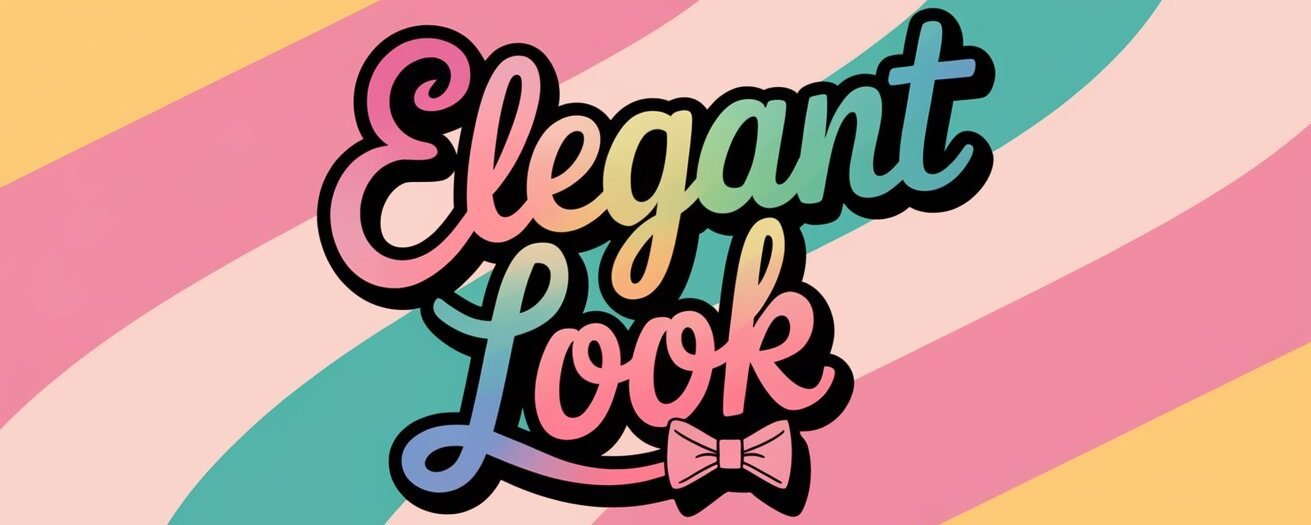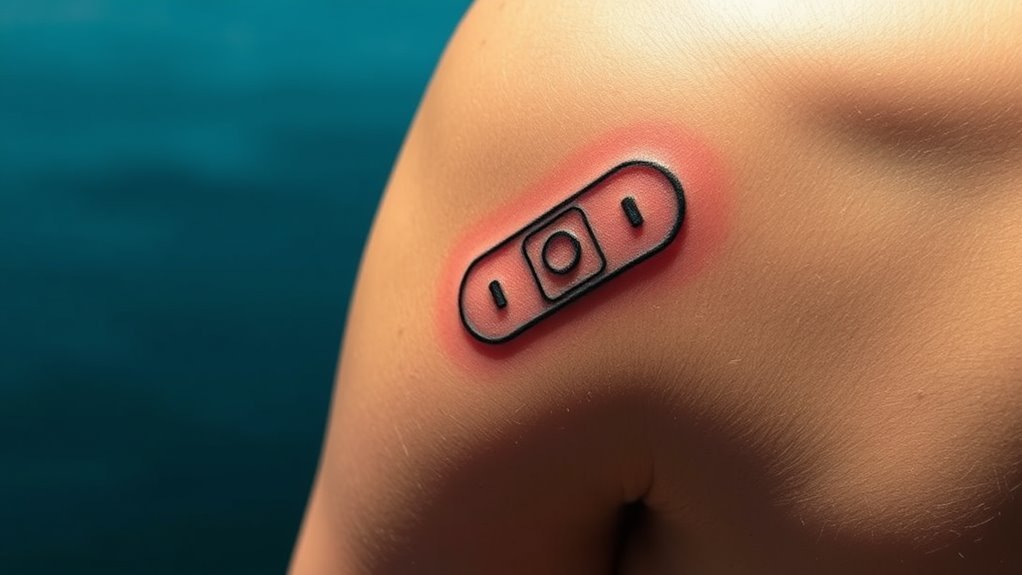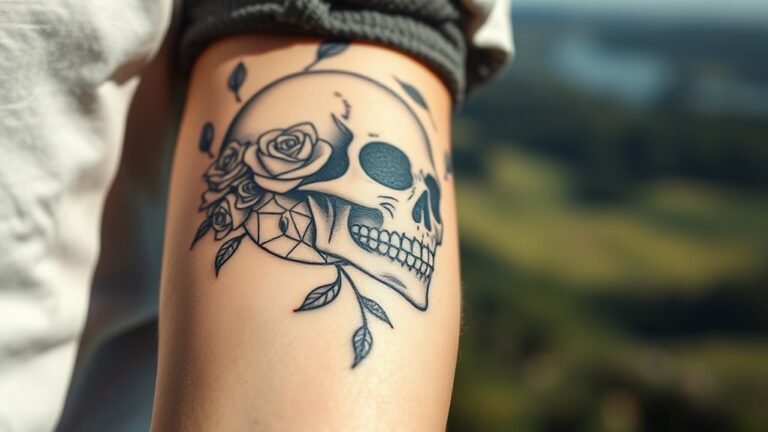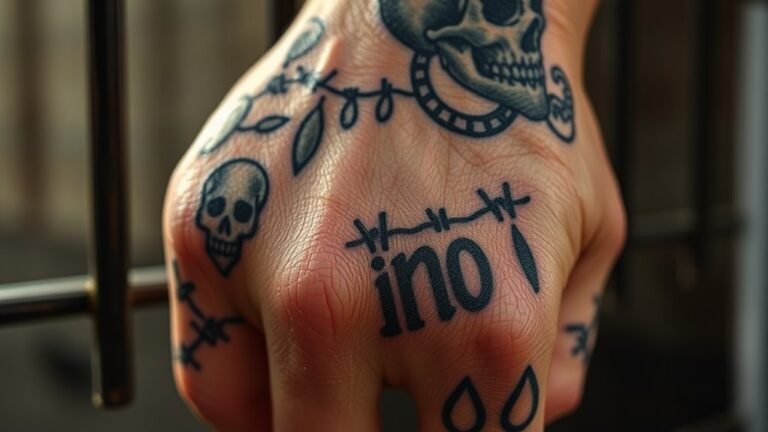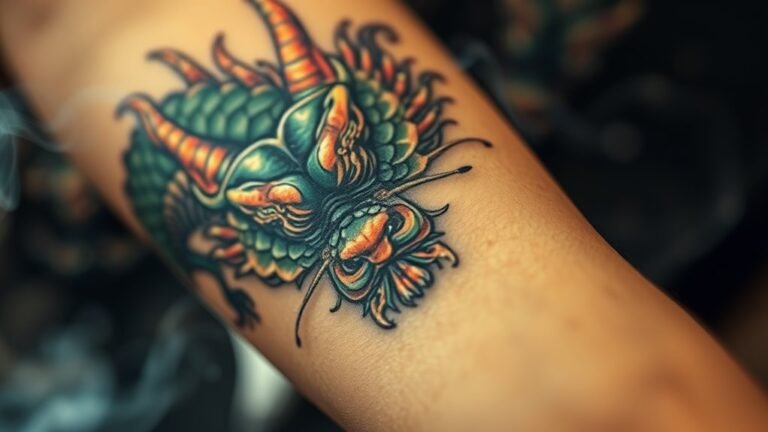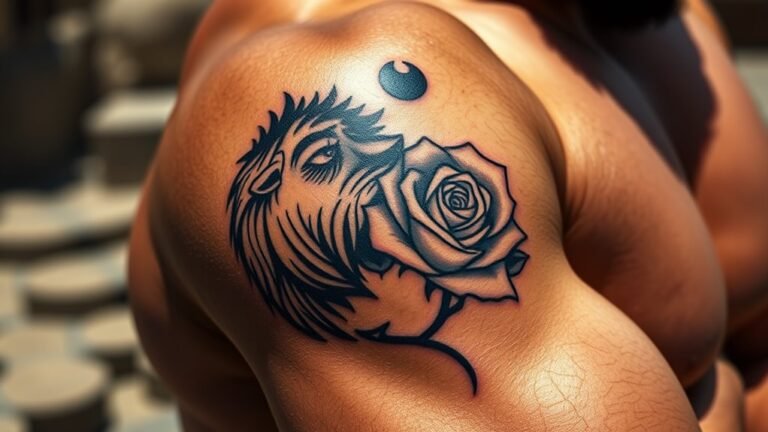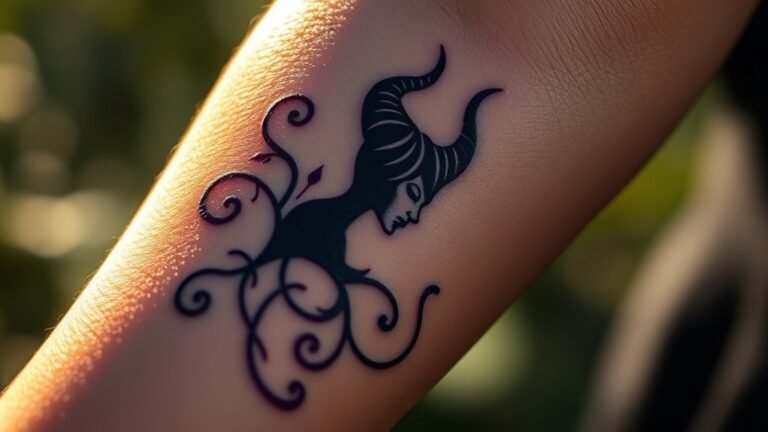Band Aid Tattoo Meaning and Symbolism
When you think about Band Aid tattoos, what comes to mind? These designs, often associated with healing and resilience, carry deeper meanings that reflect personal journeys through pain and recovery. As you explore the various styles and the stories behind them, you might find that each tattoo serves as a unique emblem of transformation. But what about the cultural interpretations and the emotional significance tied to these symbols of protection? Understanding these layers could reshape how you view your own experiences and connections to others.
In a Nutshell
- Band Aid tattoos symbolize healing and protection, reflecting humanity's instinct to mend body and spirit through art.
- They represent emotional resilience, transforming vulnerability into strength and serving as reminders of personal healing journeys.
- Common designs include minimalist outlines and watercolor effects, each reflecting unique personal stories and experiences.
- Popularized by celebrities and social media, Band Aid tattoos have become bold fashion statements that foster self-expression and connection.
- Proper care and maintenance are vital for preserving the tattoo's vibrancy, while also creating a sense of community among those with similar stories.
Historical Context of Band Aid Tattoos
Band Aid tattoos have a fascinating historical context that often surprises people. Originating as symbols of healing and protection, these designs reflect humanity's instinct to mend both body and spirit.
As tattoo evolution progressed, artists began to incorporate the Band Aid motif, transforming it into a canvas for personal stories and collective experiences. The historical significance lies in its ability to represent vulnerability and resilience, creating a sense of belonging among those who share similar journeys.
You might find that these tattoos not only commemorate struggles but also celebrate triumphs, connecting you to a broader community. In a world where scars often hide, Band Aid tattoos boldly showcase our shared narratives of healing, fostering understanding and empathy.
Common Designs and Styles
When exploring the domain of Band Aid tattoos, you'll discover a variety of designs and styles that resonate with personal significance.
From minimalist outlines to vibrant, intricate illustrations, these design variations reflect your unique story. Some opt for classic bandage shapes, while others incorporate symbols of healing, like hearts or flowers, to deepen their artistic expression.
You might choose a watercolor effect for a softer look or go bold with geometric patterns to signify resilience. Each style invites you to wear your journey on your skin, creating a sense of belonging within a community of shared experiences.
Ultimately, your choice of design becomes a tapestry of emotion and identity, celebrating both vulnerability and strength.
Emotional Healing Symbolism
Healing often emerges as a profound journey, and the symbolism behind Band Aid tattoos captures this essence beautifully.
When you choose a Band Aid tattoo, you embrace your emotional scars, acknowledging the pain while celebrating resilience. Each time you glance at your tattoo, it serves as a reminder that healing isn't linear; it's filled with ups and downs.
This ink transforms your vulnerability into strength, allowing you to connect with others who've walked similar paths. It whispers to you that it's okay to wear your wounds, and in doing so, you create a space for belonging.
Your Band Aid tattoo becomes a badge of honor in your healing journey, a symbol of survival and the beauty of moving forward.
Personal Growth Representation
As you navigate the winding path of personal growth, a Band Aid tattoo can serve as a powerful reminder of your journey.
It symbolizes the small wounds you've healed, each representing a transformative experience that has shaped who you are. Embracing this ink means acknowledging your self-discovery journey—every scar tells a story of resilience and strength.
With each glance at your tattoo, you're reminded that growth often comes from discomfort and that healing is a continual process. This tattoo connects you to others who've faced similar struggles, fostering a sense of belonging in a world where vulnerability is often hidden.
Ultimately, it's a celebration of your evolution, a badge of honor for the courage it takes to grow.
Cultural Interpretations
While many view a Band Aid tattoo as a personal symbol of healing, its cultural interpretations vary widely across different communities.
In some cultures, a Band Aid tattoo signifies resilience, representing the scars of life's battles and the strength to overcome them. In others, it may reflect a playful attitude towards vulnerability, embracing imperfections as part of the human experience.
Societal perceptions play a vital role; while some see it as a trendy statement, others might perceive it as trivializing deeper wounds.
Ultimately, the cultural significance lies in the stories you and your community share, creating a tapestry of meanings that connect you to others.
In this way, your Band Aid tattoo can foster a sense of belonging amidst diversity.
Band Aid Tattoos in Popular Culture
Band Aid tattoos have found their way into the fabric of popular culture, transforming from mere symbols of personal healing into bold fashion statements and artistic expressions.
You might notice these trendy tattoos popping up everywhere, from social media feeds to red carpets, thanks to influential figures embracing the concept.
Here are three notable ways Band Aid tattoos are shaping pop culture:
- Celebrity Band Aid: Stars like Demi Lovato and Gigi Hadid flaunt these tattoos, inspiring fans to adopt their styles.
- Social Media Trends: Platforms like Instagram and TikTok buzz with creative ways to showcase Band Aid tattoos, driving viral challenges.
- Artistic Collaborations: Tattoo artists are crafting unique designs, turning Band Aid tattoos into personalized masterpieces.
Join the movement and express your story!
The Role of Resilience
Resilience often emerges as the driving force behind the allure of Band Aid tattoos, symbolizing the strength to overcome life's challenges.
When you wear this ink, you tell your resilience narratives—stories of hardships faced, battles fought, and scars turned into art. Each Band Aid tattoo becomes a representation of your journey, showcasing the strength symbolism that resonates deeply with those who share similar paths.
You connect with others who've faced adversity, finding a sense of belonging in the shared experience of healing. This tattoo transcends mere decoration; it's a badge of honor, a reminder that you've risen above trials.
Connection to Mental Health
Healing often intertwines with mental health, and Band Aid tattoos serve as powerful symbols in this journey. They reflect your personal narrative of overcoming struggles and embracing mental health awareness.
These tattoos remind you that it's okay to show vulnerability while highlighting your coping strategies.
Here are three ways Band Aid tattoos connect to mental health:
- Resilience Reminder: Each tattoo signifies your strength in facing challenges.
- Conversation Starter: It opens doors for discussions about mental health, fostering connections with others.
- Visual Therapy: The ink becomes a personal symbol, reinforcing positive affirmations and self-care practices.
Ultimately, these tattoos embody hope and healing, creating a sense of belonging in a world where many share similar struggles.
Commemorating Loss and Grief
While traversing the tumultuous waters of loss and grief, many find solace in the poignant symbolism of Band Aid tattoos. These tattoos serve as a powerful grief expression, encapsulating the pain and healing that accompany remembrance.
Each design can represent a loved one, a cherished memory, or a moment that forever changed you. By wearing this mark, you honor their presence and acknowledge the void they've left behind.
It's a tangible reminder that grief isn't just about sorrow; it's also about love and connection. As you embrace this art, you join a community that understands the journey of loss remembrance, finding belonging in shared experiences.
In this way, Band Aid tattoos become more than ink—they become a tribute to enduring love.
Band Aid Tattoos in Recovery Stories
For many, Band Aid tattoos symbolize more than just a tribute to those lost; they also represent the journey toward recovery and self-discovery.
These tattoos can encapsulate personal stories that highlight resilience and healing. When you choose a Band Aid tattoo, you're embracing your unique recovery journey, wearing your experiences as badges of honor.
Here are three common themes found in Band Aid tattoos related to recovery:
- Healing: The Band Aid represents the process of mending emotional wounds.
- Hope: It serves as a reminder that brighter days lie ahead, no matter how tough the struggle.
- Community: Many find solidarity in sharing their stories, connecting with others on similar paths.
Each tattoo tells a powerful story of transformation and growth.
Choosing the Right Placement
Where will you wear your Band Aid tattoo? The placement can speak volumes about its personal significance.
Think about visibility—do you want it to be a daily reminder for yourself, or a conversation starter for others? Your wrist or forearm might showcase your journey openly, while a hidden spot like your back or ribs could offer a more intimate connection to your story.
Consider the emotional weight behind your tattoo; a location that resonates with you can amplify its meaning.
Your tattoo can symbolize healing and resilience, so choosing a spot that reflects your journey is essential.
Ultimately, it's about where you feel most comfortable expressing your narrative, embracing both the art and the experience it represents.
Care and Maintenance Tips
As you commence your journey with a Band Aid tattoo, understanding the care and maintenance is essential to preserving its beauty and meaning. This tattoo symbolizes healing, and nurturing it during the healing process will guarantee it remains vibrant for years to come.
- Use Quality Care Products: Invest in fragrance-free moisturizers and tattoo-specific ointments to keep your skin hydrated without irritation.
- Keep It Clean: Gently wash the area with mild soap and water, avoiding harsh scrubs that could damage the ink.
- Avoid Direct Sunlight: Shield your tattoo from the sun's rays during the healing stage to prevent fading and preserve its significance.
Frequently Asked Questions
Are Band Aid Tattoos Suitable for All Skin Types?
Band aid tattoos can suit various skin types, but you should consider your skin sensitivity first. Proper tattoo aftercare is essential; it guarantees your ink heals beautifully, making you feel confident and connected with your body art.
Can Band Aid Tattoos Be Covered With Other Designs Later?
Absolutely, you can cover Band Aid tattoos with new design options. Just consider your skin's healing and whether tattoo removal might be necessary first. Embrace creativity, and let your body reflect your ever-evolving story!
What Is the Average Cost of a Band Aid Tattoo?
The average cost of a band aid tattoo varies, influenced by tattoo pricing factors like size, artist experience, and location. Following current band aid tattoo trends, you might expect to spend anywhere from $50 to $200.
How Long Do Band Aid Tattoos Typically Last?
Band aid tattoos typically last anywhere from a few days to a couple of weeks. With proper skin care, you can enhance tattoo longevity, ensuring it stays vibrant and meaningful for as long as possible.
Do Band Aid Tattoos Hurt More Than Regular Tattoos?
You might find that band aid tattoos' pain perception varies with tattoo placement. Areas with more nerve endings can feel more intense, but overall, it shouldn't differ drastically from regular tattoos. Trust your body's unique response!
